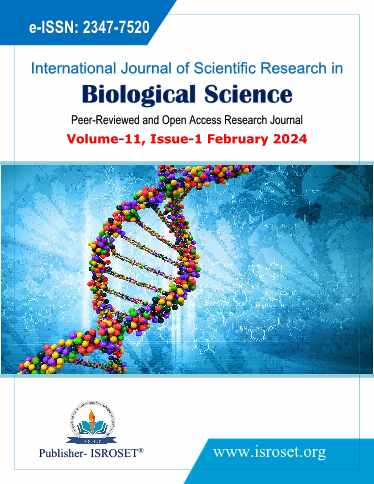Examining the use of African mistletoe (Tapinanthus globiferus (A. digitata) from Dutsin-Ma to control human fungal infections
Keywords:
Fungi, T. globiferus A. digitate, Phytochemical screening, Extract, Antifungal screeningAbstract
Numerous skin conditions are mostly brought on by fungi, particularly in underdeveloped nations. Chemotherapies may be derived from natural compounds with therapeutic efficacy. Without any supporting evidence, Tapinanthus globiferus has been widely used in ethnomedicine to cure fungal infections, diabetes, cancer, ulcers, and hypertension. The purpose of this study was to use agar well diffusion techniques to screen the phytochemical constituents and assess the antifungal properties of T. globiferus`s aqueous methanolic leaf extract against a few clinical fungal isolates, such as Alternaria nees, Microsphaeropsis arundis, and Aspergillus niger. The African mistletoe Tapinanthus globiferous is a parasitic plant that grows on several plants, including citrus, Videx doniana, Adensonia digitatata, Piliostigma thonningii etc. Saponins, tannins, cardiac glycosides, steroids, terpenoid, and flavonoids were detected in the Aqeous methanolic leaf extract of T. globiferus growing on Vitex doniana, Adensonia digitata, Vitellaria paradoxa, and Piliostigma thomningiii, but terpenoid was not present in the T. globiferous growing on Vitellaria paradoxa.. The presence of this antifungal activity of T. globiferous is not as a result of a single phytochemical. The MIC of T. globiferous growing on the host plants was determined using disc diffusion method. The antifungal activity of T. globiferous growing on the respective host plants increase with increase in concentration. At some concentration the activity of the extract is higher than that of Fluconazole. All the fungal isolates are susceptible to T. globiferous except Microsphaeropsis arundis. Since the aqueous methanolic leaf extract of T. globiferus exhibits strong antifungal activity against a few chosen fungus species and clearly supports the plant`s ethnomedical use in treating fungal infections, the use of this plant as an antifungal drug seems encouraging.
References
G.D. Brown., D.W. Denning., N.R. Gow., O.K. Afolabi. J.A.O Ojewole, Hidden killers: human fungal infections. Sci Trans Med; Vol 4 pp.165-13, 2012.
Y.Y.Deeni., N.M. Sadiq Antimicrobial properties and Phytochemical constituent of the leaves of African mistletoes ( Tapinanthus dodoneifolius CDC ) Danser ( Loranthaceae ) an ethnomedicial plant of Hausa land. Northern Nigeria Journal Ethnopharmacol.83: 225 -240, 2002.
M.E. Halilu., L.G, Hassan Liman., M.G, A., Babagana., C.J., Y., Ugwah Oguejiofor Audu Comparative studies on phytochemical and antioxidant activities of Tapinanthus globiferus (A. Rich) and its host plant Piliostigma thonningii (Schum, Advance). Pharmaceutical Journal 2 (5): 179-184, 2017.
A. S.Adekunle., B.E. Oyewo., O.K. Afolabi., Therapeutic efficacy of Tapinanthus globiferus on acetaminophen induced nephrotoxicity, inflammatory reactions and oxidative stress in albino rats. International research Journal Biochemistry Bioin 2(2):41-45, 2012.
Abubakar K., Adebisi I.M., Ugwah-Oguejiofor J.C., Idris G.O., Idris B2 & Mshelia H.E., Phytochemical Screening and Anticonvulsant Activity of the Residual Aqueous Fraction of Tapinanthus globiferus Growing on Ficus glums. Herb Med; 2:2, 2016.
L. Rodriguez-Fragoso., J. Reyes-Esparza., S.W. Burchiel., D. Herrera-Ruiz., E. Torres, Risks and benefits of commonly used herbal medicines in Mexico. Toxicology and Applied Pharmacology 227 (1), 125-135, 2008.
M.O. Fatope and I. Hamisu Screening of higher plants reputed as pesticides using Brie Shrimp lethality assay. International Journal of Pharmacognosy. 31:250-60, 1993.
A. Kabiru., E. Serin., B. Gunduz,. and A.T. Ucer, The Effects of Mistletoe (Viscum album L. Subsp. album) Extracts on Isolated Intestinal Contractions. Turkey Journal of Biology.32:237-242, 2008.
Clinical and Laboratory Standards Institute (CLSI). Reference method for broth dilution antifungal susceptibility testing of yeasts: Approved standard M27-A2. Wayne (PA) 2002.
A.K. Olowosulu Ibrahim, Y.K.E, P.G Bhatia, Studies on the antimicrobial properties of formulated creams and ointments containing Baphia nitida heartwood extract. Journal of Pharmaceutical Bioresearch; 2(2):124-130.2005.
K.O. Akinyemi., O. Oladapo., C.E. Okwara., C.C. Ibe and K.A. FasureScreening of crude extracts of six medicinal plants used in South - West Nigerian unorthodox medicine for anti-methicillin resistant S. aureus activity. BMC Complimentary Alternative Medicine. 5:6, 2005.
D.D. Paola., C. Andrea., A. Diego, Antifungal activity of medicinal plant extracts against phytopathogenic fungus Alternaria Spp. Chilean Journal of Agricultural Research; 71(2): 234, 2011.
L. G. Hassan., M.E Liman., M.G. Halilu., A. Babagana Ugwah., C.J. Oguejiofor., Y. Audu. Comparative studies on phytochemical and antioxidant activities of Tapinanthus globiferus (A. Rich) and its host plant Piliostigma thonningii (Schum, Advance). Pharmaceutical Journal 2 (5): 179-184, 2017.
M.S. Malami., M.M. Mainasara., A.A., Aliero., B.L. Aliero., H.M. Maishanu. Phytochemical screening of African mistletoes Tapinanthus globiferus (A. Rich) Tieghem (loranthaceae) on some host species in Birnin-Kebbi, Nigeria. Elixir Biosciences 107 47019-47023, 2017.
V. Emaikwu., I.G. Ndukwe., O.R.A Iyun, J.V. Anyan, Preliminary Phytochemical and Antimicrobial Activity Screening of Crude Extracts of Bird lime (Tapinanthus globiferus). Journal of Applied Science Environmental Management. 23:1-14, 2019.
G.M. Cragg., D.J. Newman, Biodiversity: A continuing source of novel drug leads. Pure and Applied Chemistry 77: 7-24, 2005.
Abedo JA, Jonah OA, Abdullahi. Evaluation of trypanosomal activity of Tapinanthus globiferus and Gongronema latifolium on Trypanosoma congolense. Bioscience Research; 10:2-8, 2013.
Hussain, F. and H. Sher. Ethnomedicinal uses of plants of district Swat, Pakistan. Pakistan Journal of Plant Science, 11 (2): 137-158, 2005.
Downloads
Published
How to Cite
Issue
Section
License

This work is licensed under a Creative Commons Attribution 4.0 International License.
Authors contributing to this journal agree to publish their articles under the Creative Commons Attribution 4.0 International License, allowing third parties to share their work (copy, distribute, transmit) and to adapt it, under the condition that the authors are given credit and that in the event of reuse or distribution, the terms of this license are made clear.







